2016 BMW 7-Series First Drive
The Monticello Motor Club is a country club with a racetrack instead of a golf course. Performance car owners in the New York metropolitan area join to take advantage of the reconfigurable road course that features up to 3.6 miles of track, as many as 22 turns, and 450 feet of elevation changes. Automakers have chosen this venue to show off the prowess of such sporty cars as the Cadillac CTS-V, Lexus RC F, and even the gonzo McLaren 650S. While BMW has also been here with the 1 Series M, you would never expect an all-new 7-Series, the brand’s luxury flagship, to tackle the twists and turns of this country club road course. You’d be wrong.
ALSO SEE: Barracuda Coming Back As A Dodge?
Completely redesigned for 2016, the new 7-Series is the sixth generation of BMW’s largest and most expensive car. It returns in just three models at launch: the six-cylinder-powered 740i and the V-8-motivated 750i and 750i xDrive, the latter with all-wheel drive. A 740i xDrive and a 740e plug-in hybrid will arrive soon, but the V-12 760 and diesel 740d do not return, and neither does the short wheelbase body style, as all 2016 7-Series have a long wheelbase that adds an inch of rear legroom.
The 7-Series competes with the likes of the Audi A8, Jaguar XJ, Lexus LS, and the luxury benchmark, the Mercedes-Benz S-Class. With such stiff competition, BMW’s goals with the new 7 were threefold: make it more luxurious than ever, introduce new technology, and improve its dynamic character. We traveled to New York to drive the new 7 on the track at Monticello and on the streets around the facility to find out how well BMW has accomplished those goals.
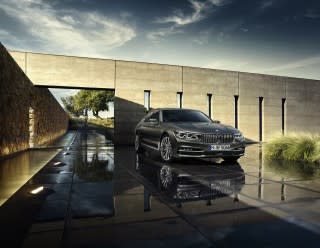
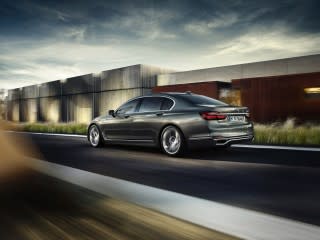
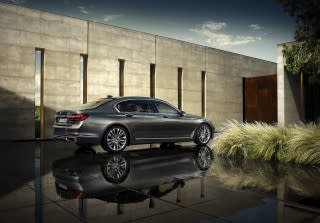
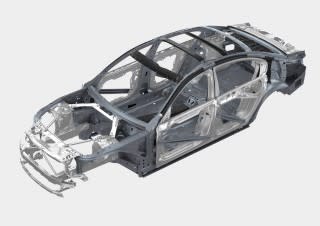
Big car, sporty dynamics
BMW’s larger cars have gotten paunchy in their middle age, and the last 7-Series was certainly guilty of putting on a few extra pounds. With this in mind, BMW engineers knew they would have to take weight out of the new 7-Series, and they started by developing a new “Carbon Core” platform made from high-strength steel, aluminum, and carbon fiber-reinforced plastic. The carbon fiber is used in key areas where it will do the most good, namely in the central tunnel, the pillars, and roof. The new structure saves about 90 pounds, improves rigidity, and reduces interior noise. Putting the carbon fiber up high also helps lower the car’s center of gravity.
READ: Jeep Grand Cherokee Trackhawk: 0-60 In 2.7 Seconds, $79,999?
To further reduce weight, BMW used lighter weight suspension components to cut 15 percent of the unsprung mass, formed the doors and trunklid from aluminum, employed lightweight bonding techniques, and added thermal and acoustic shielding to the engine to reduce the amount of sound insulation needed. All told, the new 7-Series is up to 190 pounds lighter than the car it replaces.
The lighter structure teams with a perfect 50/50 front/rear weight balance and a host of suspension technologies to provide a sportier, yet comfortable driving experience. The double wishbone front suspension and five-link rear suspension are aided by standard four-corner air suspension and electrically controlled dampers. The air suspension can raise the car about an inch to better deal with steep driveways or bumpy roads and lower it about a half inch to improve aerodynamics on the highway. The dampers can be set for a firmer or more comfortable ride.
Like the last model, the new 7-Series is also available with Dynamic Drive active roll bars, which are part of the new Active Comfort Drive with Road Preview system. This system uses the air suspension, dampers, and active roll bars to adjust the ride quality automatically. It interprets data from driver inputs and uses information from the navigation system to read the road ahead to determine if the various settings should be aimed at sportiness or comfort. Buyers can also opt for BMW’s revised Integral Active Steering, which features up to three degrees of rear steering angle and a new variable ratio steering rack.
The dampers, steering, throttle, and transmission are all adjustable in the standard Driving Dynamics Control system, which has Sport, Comfort and Comfort + settings. We tried all of the settings on the street and track and found that they accomplish their goals nicely.
CHECK OUT: Dodge SRT Hellcats And HEMIs Could Die In 2019
Nobody in their right mind would take their full-size luxury sedan on a racetrack, but it’s good to know that the 2016 BMW 7-Series can handle such abuse. Running in Sport mode, the new 7 did things on a 1.8-mile stretch of track that seemed to bend the laws of physics. The cars we drove were all 750 xDrive models with the Active Comfort Drive system. The active roll bars helped keep the car relatively flat through corners and wrestle its 4600-pound curb weight from turn to turn like a smaller, lighter car. The steering, while light, was pleasantly quick, and the brakes provided a good pedal feel without fading or warping. We can’t imagine subjecting a Mercedes-Benz S550 to this type of treatment.
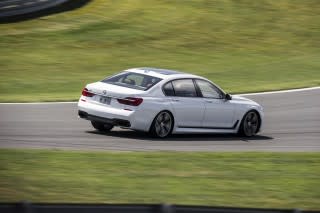
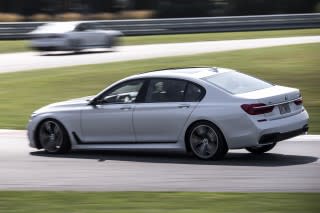
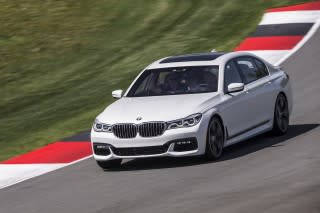

The street, however, is where the 2016 7-Series showed its true colors. The twin-turbocharged 4.4-liter V-8 and 8-speed automatic transmission are silky smooth, delivering all 445 horses with little fuss. BMW says the 750i is capable of a 4.3-second 0 to 60 mph sprint. That seems a bit of a stretch to us, but no 750i owner will ever want for power.

 Yahoo Autos
Yahoo Autos 